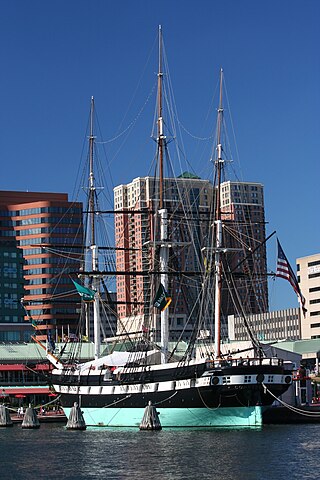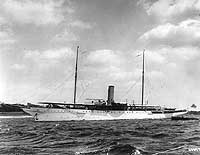
The ensign is a maritime flag that is used for the national identification of a ship. The ensign is the largest flag, generally flown at the stern (rear) of the ship while in port. In ports, depending on the ship's origin, it is sometimes identical with a jack on the bow of the ship. Jacks are more common on warships than on merchant ships.

USS Constellation is a sloop-of-war, the last sail-only warship designed and built by the United States Navy. She was built at the Gosport Shipyard between 1853 and 1855 and was named for the earlier frigate of the same name that had been broken up in 1853. The sloop's primary armament was 8-inch (203 mm) shell-firing guns and four 32-pounder long guns, though she carried other guns as well, including two Parrott rifle chase guns. Constellation's career as a front-line unit was relatively short; after entering service in 1855, she served with the Mediterranean Squadron until 1858, and in 1859, she was assigned as the flagship of the Africa Squadron, where she served with the African Slave Trade Patrol. During the American Civil War (1861–1865), the ship returned to the Mediterranean to patrol for Confederate vessels. In late 1864, she returned to the United States to be decommissioned, as most of her crews' enlistments had expired. She spent the rest of the war out of service.

USS Santee was a wooden-hulled, three-masted sailing frigate of the United States Navy. She was the first U.S. Navy ship to be so named and was one of its last sailing frigates in service. She was acquired by the Union Navy at the start of the American Civil War, outfitted with heavy guns and a crew of 480, and was assigned as a gunboat in the Union blockade of the Confederate States. She later became a training ship then a barracks ship for the U.S. Naval Academy.

USS Aquamarine (PYc-7) was the former yacht Siele launched in April 1926 by Pusey and Jones Corporation, Wilmington, Delaware. In 1940 Siele was sold and renamed Sea Wolf which was purchased by the Navy in January 1941 and commissioned Aquamarine in April. Though given a "patrol yacht, coastal" designation the yacht was assigned to the Naval Research Laboratory for acoustical research during World War II. After naval service the yacht was again under the name Sea Wolf until sold in 1954 and renamed Miss Ann, listed on the U.S. National Register of Historic Places in 1998.

America was a 19th-century racing yacht and first winner of the America's Cup international sailing trophy.

USS Mayflower (PY-1) was a 275 ft (84 m), 2,690 t (2,650 LT) motor vessel originally built as a private yacht that went on to serve in a variety of military, governmental, and commercial roles.

USS Reina Mercedes (IX-25) was an unprotected cruiser of the Spanish Navy which was captured in Cuba in 1898 by the U.S. Navy during the Spanish–American War. She was refurbished and used by the U.S. Navy as a non-self-propelled receiving ship at Newport, Rhode Island, and subsequently as a detention vessel and barracks ship for the United States Naval Academy in Annapolis, Maryland, until 1957.

USS Isabel (SP-521), later PY-10, was a yacht in commission in the United States Navy as a destroyer from 1917 to 1920 and as a patrol yacht from 1921 to 1946.

Lanikai, was a wooden hulled schooner-rigged diesel powered yacht in service with the United States Navy during both World War I and World War II, before being transferred to the Royal Australian Navy.

The Atlantic was a three-masted schooner built in 1903 by Townsend and Downey shipyard on Shooters Island, New Jersey. She was designed by William Gardner, and Frederick Maxfield Hoyt for Wilson Marshall.

HMCS Beaver was an armed yacht that served in the Royal Canadian Navy during the Second World War. Originally named Aztec, the yacht was requisitioned for service in the United States Navy during the First World War under the same name. Returned to her owner in 1919, the yacht was laid up in 1931 following her owner's death. The vessel was purchased via a third party for service in the Royal Canadian Navy and after commissioning, Beaver was primarily used as a training ship with limited time as a patrol vessel. Following the war she was sold in 1946 and broken up for scrap in 1956.

USS Oceanographer (AGS-3) was a survey ship of the United States Navy during World War II that produced charts chiefly of passages in the Solomon Islands area of the Pacific Ocean. Upon transfer to the Navy, she had initially briefly been named and classed as gunboat USS Natchez (PG-85). Before her World War II Navy service, she had been USC&GS Oceanographer (OSS-26), a survey ship with the United States Coast and Geodetic Survey from 1930.

USS Hewell (AG-145/AKL-14) was a Camano-class cargo ship constructed for the U.S. Army as FS-391 shortly before the end of World War II. FS-391 operated with a U.S. Coast Guard crew in the Southwest Pacific area. The ship was acquired by the U.S. Navy in 1948. She was configured as a transport and cargo ship and served with the U.S. Pacific Fleet – including highly decorated service during the Korean War – until decommissioned in 1955.
USS Sardonyx (PYc-12), formerly the yacht named Queen Anne (1928), was a patrol boat in the United States Navy during World War II.

USS Owera (SP-167), was an armed yacht that served in the United States Navy as a patrol vessel from 1917 to 1919. The vessel, under the name O-We-Ra, was built as a steam yacht in Leith, Scotland in 1907 for Frederick H. Stevens of Buffalo, New York. In 1915 the yacht was sold to United States Senator Peter G. Gerry of Rhode Island and registered in Providence, Rhode Island as Owera.

The first USS Sabalo (SP-225) was a United States Navy patrol vessel in commission from 1917 to 1919. Following World War I, Sabalo was sold to private interests before returning to service as a patrol vessel in World War II, this time with the Royal Canadian Navy, renamed Cougar. Returning to private ownership following the war, the vessel sank in a hurricane in 1950.

USS Sapphire (SP-710) was a United States Navy patrol vessel in commission from 1917 to 1918.
Maryann, sometimes seen as Maryanne or Mary Anne, was a yacht requisitioned and converted by the United States Navy during the defense of the Philippines in World War II and destroyed 5 May 1942 at Corregidor to prevent capture. The yacht was "in service" and not commissioned.
USS Palomas (IX-91) was a two-masted, steel-hulled, Miscellaneous Unclassified-Schooner in service with the United States Navy. She served during World War II, and briefly after the war. She was sold for disposal by the Maritime Commission in 1947.

Hodgdon Yachts is a builder of yachts and specialized military vessels, based in East Boothbay, Maine. It is a family-run business that was founded in 1816—the oldest continuously operating family boatbuilder in the United States, antedating the Burger Boat Company in Wisconsin. Hodgdon Yachts is noted for building superyachts, both sail and power, using advanced composite materials and construction techniques. It's also noted for its ability to incorporate those advanced materials into traditional designs that employ modern electronic and mechanical marine systems. The company has several divisions—yachts, custom tenders, yacht interiors, yacht services and military composites with offices in Boothbay, Maine, Newport, Rhode Island and Monaco.
















